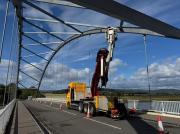Eradication of Invasive Crayfish in Ballachulish Quarry
5th June 2012
The Highland Council has confirmed proposals for the eradication of North American signal crayfish in Ballachulish Quarry this summer. The site is currently owned by the Council and managed by the Planning and Development Service for public recreation. The crayfish, a small lobster like species that can have a devastating effect on native wildlife, were first discovered in the Ballachulish Quarry pond by one of the Council's own Countryside Rangers in August 2011.
This is the first time that signal crayfish, have been found in Lochaber and it is the most northerly recorded occurrence of this species on the west coast of Scotland. Where they occur, signal crayfish can compete with fish for food and shelter, and they can be a significant predator of a range of freshwater animals. This means that their presence is of concern to conservationists and anglers alike.
Since making the discovery The Highland Council has been in liaison with a number of stakeholders and agencies, including Lochaber Fisheries Trust, Scottish Environment Protection Agency (SEPA) and Scottish Natural Heritage (SNH). Detailed proposals for eradication have been prepared by the Lochaber Fisheries Trust and an appropriate course of action has now been agreed.
The eradication attempt will involve the controlled application of a chemical called Pyblast to the two ponds in the quarry and this work is planned to commence on June 11th 2012, subject to suitable weather conditions, and is expected to complete within a four week period. Pyblast is toxic to fish, crustacea and insects but has very low toxicity to mammals and birds, so the risk to humans or any otter, mallard, heron and domestic dogs that use the site will be low. There are no wildlife species of conservation concern within the ponds.
The crayfish in the ponds will be killed within the first three days after treatment, after which the toxicity of the pond will begin to fall. Recovery of the pond will then be enhanced by actively pumping the water within the ponds to accelerate breakdown. Pumps will also be used to disturb and suspend the layer of sediment present on the bed of the ponds as this will also speed up the recovery process. The toxicity of the ponds will be monitored throughout and the site is expected to have returned to normal within 21 days.
The ponds have no surface connection to any other waterbody. The nearest natural freshwater waterbody to the treatment pond is the River Laroch, 400m away. There is no history of either pond flooding. The proposal to use Pyblast has been subject to formal authorisation through SEPA and approval through the Health and Safety Executive Chemicals Regulation Directorate.
Access to the ponds will be restricted during treatment and until monitoring indicates the chemical has broken down. Temporary fences will be erected around the ponds, but access to the wider site for recreational purposes, will not be restricted. Signs will be erected to make the public aware of sensible precautions and the public are reminded that it is illegal to catch or remove crayfish in Scotland without a licence. Members of the public who think they have seen signal crayfish anywhere else in the area should report this to the Lochaber Fisheries Trust.
The cost of the eradication attempt is approximately �76000, nearly half of which is the cost of the Pyblast chemical. Specialist supervision will be undertaken by the Lochaber Fisheries Trust and SPB Environmental, with manpower being supplied by Highland Council and the Fisheries Trusts. Funding has been provided by the Highland Council, SEPA and SNH and the operation will provide a valuable training opportunity for a range of Highland organisations to increase their knowledge, skills and awareness in relation to this unwelcome invasive species.
Signal crayfish were first introduced to waters in England and Wales from fish farms in the 1980s. In Scotland, they were first recorded in the catchment of the Kirkcudbrightshire Dee in 1995. Since then, specimens have been found in ponds, rivers and lochs in 13 Scottish river catchments. They are now found as far north as the Inverness area.
This species is a voracious predator which feeds on insects, frogs and young fish and their eggs. Signal crayfish also have an impact on the banks of rivers and lochs by burrowing into them. This can lead to increased erosion and damage to the spawning grounds of a variety of fish. In some situations it may cause some banks to become unstable.
Sightings of the crayfish outwith Ballachulish Quarry should be reported to the Lochaber Fisheries Trust: Tel. 01397 703728; Email Lochaberfisheriestrust[AT]gmail.com.
Related Businesses
Related Articles
Exciting Career Opportunities With The Highland Council Now Open For Applications
# 10 December 2025 Career opportunities with The Highland Council The Highland Council is looking to fill a variety of posts relating to civil engineering and flood risk management based in locations across the area. Included are opportunities specifically for civil engineering graduates and technicians, providing the ideal job with career progression for anyone recently qualified and ready for a varied and interesting role.
What the NC500 Research Projects Are Designed to Do - and Why They Matter for the Highlands
As the North Coast 500 approaches its tenth anniversary, it has become one of Scotland's most well-known tourism success stories. The 516-mile loop around the far north of the Highlands has been celebrated internationally, marketed as a world-class road trip, and credited with transforming visitor numbers in some of Scotland’s most remote areas.Help Shape the Future of Thurso
The Highland Council is inviting people that live, work, or study in Thurso, to come along to the public consultation events to have their say. This is an opportunity to help shape the future of Thurso, to gather views and ideas.
Are Scottish Councils Quietly Reversing Outsourcing? A Look at Insourcing, Cuts and the Highland IT Shift
A notable article in the Guardian on 6 December 2025 noted the high sums being paid by London councils outsourcing services to private firms. The article starts with the reduction in council funding by UK government since 2010.Council welcomes Visitor Levy flexibility plan
The Highland Council welcomes moves by the Scottish Government to introduce greater flexibility on how it could design a Visitor Levy Scheme for consultation. The Visitor Levy (Scotland) Act 2024 currently provides local authorities with discretionary powers to implement percentage-based levies following statutory consultation.Highland Council is reaching out for views to shape its next 26/27 budget.
As it looks to set out its forthcoming priorities, the council is seeking involvement from members of the public, including businesses, community groups, parents, and young people. All their opinions are going to be crucial in deciding how Highland Council will take on its budget challenge for 2026-2027.Have your say in Thurso's future £100million investment by attending public consultation events
Thurso is to benefit from £100m investment in education and community facilities and are rolling out the first phase of public consultations on 9 and 10 December 2025. The Highland Council is inviting people that live, work, or study in Thurso, to come along to the public consultation events to have their say; this is an opportunity to help shape the future of Thurso, to gather views and ideas.Finding new owners for empty homes - Scheme launched to help return more empty homes to active use
A new online portal has been launched to bring empty homeowners together with prospective buyers or developers with the aim of facilitating more properties to be used as homes again. Covering the whole of Scotland, this builds on the success of local pilots, referred to as "matchmaker schemes".Consideration for short term let control area in Skye and Raasay
Steps towards introducing a short term let control area have been considered by Highland Council's Isle of Skye and Raasay area committee. On Monday (1 December 2025) the committee heard evidence to justify the grounds for the introduction of a Short Term Let Control Area covering all or part of Skye and Raasay.Workforce North event spotlights Highland economy
EMPLOYERS and educators from across the Highlands have gathered to hear how a new initiative is aiming to transform the region's economy. Workforce North - A Call to Action brought together business leaders and teachers from primary and secondary schools from across the Highland Council area with a wide range of partners geared towards education, learning and skills development at Strathpeffer Pavillion.
